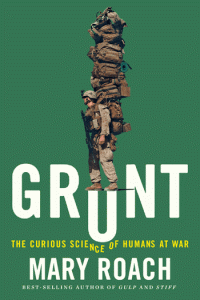Grunt: The Curious Science of Humans at War, by Roach ’81 Excerpted in NYT
 Grunt: The Curious Science of Humans at War, the new book by Mary Roach (W.W. Norton & Company; June 2016), was excerpted in the New York Times’ Science section on May 30. Describing her visit to the Aberdeen Proving Ground (“a spread of high-security acreage set aside for testing weapons and the vehicles meant to withstand them”), Roach’s first-person account offers her characteristic lively narrative and wry humor. She allows her guide, Mark Roman, to be ours as well.
Grunt: The Curious Science of Humans at War, the new book by Mary Roach (W.W. Norton & Company; June 2016), was excerpted in the New York Times’ Science section on May 30. Describing her visit to the Aberdeen Proving Ground (“a spread of high-security acreage set aside for testing weapons and the vehicles meant to withstand them”), Roach’s first-person account offers her characteristic lively narrative and wry humor. She allows her guide, Mark Roman, to be ours as well.
“’By and large, an army shows up to a war with the gear it has on hand from the last one. In 2003, the Marines arrived in Iraq with Humvees. ‘Some of the older ones had canvas doors,’ says Mr. Roman, who was one of those Marines. They were no match for the R.P.G.s trained upon them. So the Army tried plating vehicles with armor panels, which work well against heavy machine-gun fire. You might as well have armored your vehicle with road signs.
“’We were like, ‘Crap, this does not stop an R.P.G.,’ Mr. Roman told me.”
Following the successful creation of a device to stop an RPG—with what Roach describes as “a hoopskirt [for the armored combat vehicles] of heavy-duty steel grating called slat armor” in which they “would lumber back to base like up-armored hedgehogs…” —Roman notes that the insurgents then switched to making bombs.
It is through this process of the escalation of danger and that resultant need for greater protection that Roach proves a friendly guide, rendering jargon accessible and never losing sight of what is truly at stake: that while the WIAMan — the Warrior Injury Assessment Manikin—may answer questions posed in the proving grounds, a human will bear the cost of any false or incomplete answers. “The long-term quality of a soldier or Marine’s life is a relatively new consideration/ In the past, military decision makers concerned themselves more with go/no-go: Do the injuries keep a soldier from completing the mission?…The answers may or may not affect the decisions that are made in the preparations for war, but at least they’ll be part of the equation for those inclined to do the math.”
In an interview with John Bonazzo for the Observer, Roach highlighted her respect for those working behind the scenes on saving lives and lowering the risks of combat: “There’s a tremendous amount of dedication and work that doesn’t get covered very much,” she said. “I want people to come away with respect for and recognition of that work.”

